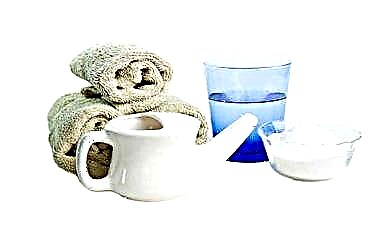Throughout the entire period of gestation, the woman's body has to work in an "enhanced mode", providing the growing embryo with everything necessary for full development. Of course, against this background, the immune defense is weakened, which predisposes the occurrence of frequent rhinitis. What to do if a stuffy nose during pregnancy?
 The suppression of immunity is also due to physiology, which is necessary to maintain pregnancy, because for him the fetus can become a "target". An undesirable consequence of this conflict is spontaneous abortion. For 9 months, the body of the expectant mother continues to be under attack by pathogenic microorganisms in the environment, which is why nasal congestion during pregnancy can become a common symptom of viral diseases.
The suppression of immunity is also due to physiology, which is necessary to maintain pregnancy, because for him the fetus can become a "target". An undesirable consequence of this conflict is spontaneous abortion. For 9 months, the body of the expectant mother continues to be under attack by pathogenic microorganisms in the environment, which is why nasal congestion during pregnancy can become a common symptom of viral diseases.
For us, a cold is not such a dangerous pathology as for a pregnant woman. Complications can be associated with damage to the placenta and embryo.
Difficulty breathing through the nose is especially dangerous in the early stages of pregnancy, when organs are laid down and intensive development occurs.
The fact is that insufficient oxygen supply to the respiratory tract of a woman is fraught with fetal hypoxia. The state of oxygen starvation is aggravated at night, when a woman falls asleep, and periods of apnea are observed. For several minutes, she does not breathe, due to which the function of internal organs is disrupted and the delivery of oxygen to the embryo worsens.
Among the possible complications, it is worth highlighting placental insufficiency, which can lead to:
- placental abruption;
- increased risk of intrauterine embryo death;
- late childbirth;
- the birth of a child with malnutrition (underweight);
- violation of cerebral blood flow in an infant;
- disorders of the respiratory tract;
- intestinal dysfunction;
- pathology of the nervous system;
- developmental defects.
In addition, with nasal congestion of bacterial origin, there is a risk of infection of the fetus during the generalization of the infection.
Difficulty breathing can be caused by:
- physiological hormonal changes, as a result of which the vascular tone changes, and swelling of the nasal mucosa appears;
- infection. These can be viruses (during primary infection) or bacteria that are activated in chronic infectious foci;
- colds (due to hypothermia, abuse of cold drinks);
- allergic reaction;
- vasomotor rhinitis, which is a consequence of diseases of the nervous, cardiovascular system;
- unfavorable living conditions.

How can I help a pregnant woman?
What to do if a stuffy nose during pregnancy? To quickly get rid of the discomfort associated with difficult nasal breathing, you need to know the exact cause of the disease.
For example, with an allergic origin of pathology, relief of the condition can be achieved only after the termination of contact of the allergen with the woman's immune system. If we consider an infectious disease that is accompanied by swelling of the nasal mucosa, antimicrobial drugs should be used in treatment. This will help speed up recovery and prevent the spread of pathogenic microbes throughout the body.
Ambient atmosphere
Treatment of nasal congestion in pregnant women, regardless of the cause of the disease, should include improving the microclimate in the home. To do this, you should:
- control the level of humidity in the room. Dry air irritates the nasal mucosa, impairs the performance of the purifier and reduces local protection. It is possible to maintain humidity at 65% using a special device (humidifier) or in a simpler way.
 It is enough to place containers with water in the room (preferably near a heat source), hang out wet linen or increase the number of houseplants, not forgetting to take care of them;
It is enough to place containers with water in the room (preferably near a heat source), hang out wet linen or increase the number of houseplants, not forgetting to take care of them; - reduce the room temperature to 20 degrees. This will help relieve congestion and improve nasal breathing;
- regularly ventilate the room, carry out wet cleaning. If you often get a stuffy nose during pregnancy, it is advisable to take care of the cleanliness of the room. This will help reduce the concentration of dust, germs, and allergens in the air.
General mode
To alleviate the condition of a woman, it is necessary to normalize the daily regimen and follow some recommendations:
- drinking volume. You need to drink about 1.5 liters of water per day, which allows you to ensure the normal course of vital processes in both organisms. It is required to exclude coffee from the diet, as well as drinks containing caffeine. It is advisable to drink still water, unsweetened compote, fruit drink, juices or herbal tea. Sufficient fluid intake makes it possible to maintain an optimal water-electrolyte balance and avoid dehydration;
The amount of liquid drunk per day must be agreed with the doctor so as not to aggravate the course of hypertension, toxicosis or other diseases in a pregnant woman.
- allergens. If you suspect an allergy, you need to get rid of all possible allergens. For example, you should give pets to relatives, reduce the number of items that can accumulate dust (carpets, books). In addition, it is required to remove chocolate, seafood, honey, eggs from the nutritious diet, stop taking medications (in agreement with the doctor). If the allergy is due to the action of fluff, you may have to change your place of residence for a while;
- dress warmly before going outside in cool weather so as not to aggravate the congestion. In order to stay warm, you need to wear warm socks. Hot foot baths, mustard plasters are not used during gestation;
- daily walks in the park area can cure the disease and activate blood circulation, which is especially important during pregnancy;
- psycho-emotional and physical rest. Hormonal fluctuations against the background of stressful situations negatively affect the course of pregnancy. Bed rest during illness is necessary in order to maintain internal strength to combat pathology.
Medication assistance
How to treat nasal congestion during pregnancy? Please note that the drugs are prescribed exclusively by a doctor, taking into account the severity of the disease and the woman's condition. Drug therapy is carried out in exceptional cases when the body needs help in the fight against pathology.
Medicines are best instilled after cleansing the nasal passages with saline. This makes it possible to have a powerful healing effect.
Vasoconstrictor drugs are used only if the nose is heavily stuffy during pregnancy, as well as when otitis media and other complications are threatened. Medicines are prescribed in a short course, up to 5 days, after which they can be replaced with homeopathic remedies.
Among medicines with vasoconstrictor properties, Vibrocil, Nazivin 0.01% should be distinguished. Despite the low risk of side effects, you should not abuse these drugs.
In case of exceeding the recommended doses or the duration of the therapeutic course, the mucous membrane may dry out, as well as the development of drug-induced rhinitis.
Most often, doctors prescribe homeopathic, herbal preparations that have a lesser effect on the fetus. They can be used much longer than vasoconstrictor drugs.
Useful procedures
Drug therapy should be supplemented with some procedures, due to which the therapeutic effect of the drugs is enhanced and nasal breathing is facilitated much faster.
Rinsing the nose
 How to get rid of nasal congestion? Saline is the drug of choice for relieving nasal congestion. Among the drugs in this group are Aqua Maris, Dolphin, Humer, Aqualor.
How to get rid of nasal congestion? Saline is the drug of choice for relieving nasal congestion. Among the drugs in this group are Aqua Maris, Dolphin, Humer, Aqualor.
At home, you can prepare a solution for rinsing the nasal cavities yourself. To do this, carefully dissolve 3 g of salt in 310 ml of warm boiled water.
The procedure should be carried out over a bathtub or washbasin. First you need to bend over, turn your head to the right and insert the spout of the container with liquid into the right nasal passage. Water begins to flow by gravity into the cavity and flow out of the left passage. Thus, the nose is rinsed. You can relieve congestion with saline up to 5 times a day for a long period of time.
It is strictly not recommended to pour liquid into the nasal cavities under pressure (from a syringe) or force the solution to be drawn in through the nostril, while closing the second nasal passage.
After the procedure, you should blow your nose to cleanse the nasal passages of mucus, dust and microbes. After that, you can drip two drops of saline solution into the nose to further moisturize the mucous membrane.
Local heating
When a stuffy nose during pregnancy due to a cold, you can use a proven method - to warm up the paranasal area. The procedure is prohibited in case of fever, a serious condition of a woman, as well as a violation of the integrity of the skin of this area.
For warming, you can use a boiled egg, potatoes, or a bag of salt. The heat source should be wrapped with a cloth to prevent skin burns. If you feel a burning sensation when touched, it is recommended to add another layer of fabric.
The duration of the procedure is usually 15 minutes. It is recommended to get rid of congestion in this way immediately after hypothermia, when the nose is just beginning to fill up.
Folk recipes
You can also eliminate congestion with the help of folk recipes. However, it is worth remembering that pregnancy is not a time for testing, so new folk remedies that you did not use before pregnancy should not be used.
Nasal congestion during pregnancy can be helped by:
- aloe juice. Thanks to its antimicrobial, anti-inflammatory effect, the plant helps to cope with infectious rhinitis. First, you need to cut the plant, leave it in a dark tissue in the refrigerator for 12 hours, which is necessary to activate biologically active substances. To prepare the medicine, you should clean the aloe, chop it, and then squeeze the juice. It must be diluted with boiled water (1: 1) and the nasal passages must be dripped in two drops;
- inhalation with onions, garlic. Peel the ingredients, chop and wrap with a handkerchief. Within 10 minutes, you need to inhale the vapors;
- Pregnancy treatment may include the use of laundry soap. To do this, it is enough to make a soapy solution and lubricate the inner surface of the nose. The procedure can be repeated twice a day.
No matter how the pregnant woman is treated, medical supervision is necessary in any case. It is important for assessing the dynamics of therapy, determining the risk to the fetus, as well as timely correction of treatment.

 It is enough to place containers with water in the room (preferably near a heat source), hang out wet linen or increase the number of houseplants, not forgetting to take care of them;
It is enough to place containers with water in the room (preferably near a heat source), hang out wet linen or increase the number of houseplants, not forgetting to take care of them;

